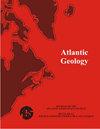Deformation of soft sediments and evaporites in a tectonically active basin: Bay St. George sub-basin, Newfoundland, Canada
IF 0.9
4区 地球科学
Q2 GEOLOGY
引用次数: 2
Abstract
The Bay St. George sub-basin of SW Newfoundland, part of the larger late Paleozoic Maritimes basin, formed under the influence of strike-slip faulting and the movement of evaporites. New stratigraphic correlations between Newfoundland and other late Paleozoic sub-basins illustrate the effects of both basement and salt movement. Coastal outcrops show complex combinations of synsedimentary, salt-related, and tectonic structures. Map relationships and dramatic thickness contrasts in the Tournaisian Anguille Group indicate that a large, concealed, NE–striking normal growth fault (Ship Cove fault) controlled sedimentation; the exposed Snakes Bight fault originated as a hanging-wall splay. Structures formed during, or soon after deposition include soft-sediment folds, boudins, clastic dykes, and millimetre-scale diapiric bulb structures, formed by overpressuring and liquidization of sediment. These suggest that the sub-basin was tectonically active throughout deposition. Evaporite-related deformation is recorded in the Visean Codroy Group and overlying strata. Comparisons between outcrop and subsurface suggests that significant amounts of evaporite were removed from exposed sections by halokinesis and solution. Complex outcrop relationships indicate salt welds, and suggest that units of the upper Codroy and overlying Barachois groups represent fills of minibasins that subsided into thick evaporites. Field relationships suggest tectonic inversion deposition related to E-W dextral strike slip motion that affected the entire Maritimes basin in the Serpukhovian, producing reverse-sense offsets and contractional folds. Many of the structures in the Bay St. George sub-basin, previously interpreted as post-depositional and purely tectonic, were formed by deformation of unlithified sediment and ductile evaporites during basin development.构造活动盆地中软沉积物和蒸发岩的变形:加拿大纽芬兰圣乔治湾次盆地
纽芬兰西南部圣乔治湾次盆地是在走滑断裂和蒸发岩运动的影响下形成的,是较大的晚古生代海相盆地的一部分。纽芬兰与其他晚古生代次盆地之间新的地层对比说明了基底运动和盐运动的影响。沿海露头表现出同沉积、盐相关和构造构造的复杂组合。图尔奈-安圭列群的图图关系和显著的厚度对比表明,一条巨大的、隐蔽的、北东向的正生长断层(船湾断层)控制了沉积;暴露的蛇湾断层起源于上壁式断层。沉积期间或沉积后不久形成的构造包括软沉积褶皱、包体、碎屑岩墙和毫米级底辟球状构造,这些构造是由沉积物的超压和液化形成的。这表明该次盆地在整个沉积过程中都处于构造活动状态。在Visean Codroy群及其上覆地层中记录了与蒸发岩有关的变形。露头和地下的比较表明,通过盐蚀作用和溶液从暴露剖面中除去了大量的蒸发岩。复杂的露头关系表明存在盐焊缝,表明上Codroy单元和上覆Barachois群代表了沉降成厚蒸发岩的小型盆地的充填。场关系表明,构造反转沉积与东西向右走滑运动有关,该运动在谢尔普霍夫期影响了整个海相盆地,产生了逆意义偏移和收缩褶皱。海湾圣乔治次盆地中的许多构造,以前被解释为沉积后的纯构造,是在盆地发育过程中由非岩化沉积物和韧性蒸发岩变形形成的。
本文章由计算机程序翻译,如有差异,请以英文原文为准。
求助全文
约1分钟内获得全文
求助全文
来源期刊

Atlantic Geology
GEOLOGY-
CiteScore
2.10
自引率
18.80%
发文量
0
审稿时长
>12 weeks
期刊介绍:
Atlantic Geology (originally Maritime Sediments, subsequently Maritime Sediments and Atlantic Geology) covers all aspects of the geology of the North Atlantic region. It publishes papers, notes, and discussions on original research and review papers, where appropriate to the regional geology.
 求助内容:
求助内容: 应助结果提醒方式:
应助结果提醒方式:


